Pyruvate decarboxylation - Study guides, Class notes & Summaries
Looking for the best study guides, study notes and summaries about Pyruvate decarboxylation? On this page you'll find 152 study documents about Pyruvate decarboxylation.
Page 4 out of 152 results
Sort by
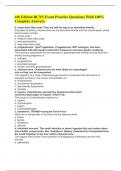
-
4th Edition BCNS Exam Practice Questions With 100% Complete Answers.
- Exam (elaborations) • 29 pages • 2024
-
- $18.99
- + learn more
4th Edition BCNS Exam Practice Questions With 100% Complete Answers. d. long-chain fatty acids They are still too big to be absorbed directly Examples of dietary nutrients that are not absorbed directly into the enterohepatic portal blood system include: a. amino acids. b. medium-chain fatty acids. c. monosaccharides. d. long-chain fatty acids. b. progesterone. "gest"=gestation. Progesterone, NOT estrogen, has been associated with decreased contraction frequency and slow gastric empty...
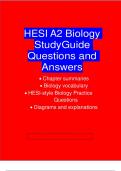
-
HESI A2 Biology Study Guide Questions and Answers
- Exam (elaborations) • 48 pages • 2023
-
Available in package deal
-
- $15.39
- + learn more
HESI A2 Biology Study Guide Questions and Answers Cellular respiration is the process inside of cells that converts nutrients (such as sugars, amino acids, and fatty acids) into ATP (adenosine triphosphate), which is used throughout the organism for energy. Large molecules are broken into smaller molecules, which releases both energy and waste. Aerobic respiration occurs in the presence of Oxygen and has four main stages: • Glycolysis: Larger sugar molecule is broken down into 2 smaller sug...

-
Karp Cell and Molecular Bio Chpt 5 Exam 2023 Marking Scheme
- Exam (elaborations) • 5 pages • 2023
- Available in package deal
-
- $11.49
- + learn more
Karp Cell and Molecular Bio Chpt 5 Exam 2023 Marking Scheme metabolism - ANSWER- the collection of biochemical reactions that occur within a cell metabolic pathways - ANSWER- sequences of chemical reactions, each catalyzed by a specific enzyme. Usually confined to specific locations. Convert substrates into end products via a series of metabolic intermediates catabolic pathways - ANSWER- pathways that break down complex substrates into simpler end products to 1) provide raw materials f...

-
Biology 150 Exam 2 Questions and Answers | 100% Correct
- Exam (elaborations) • 4 pages • 2024
- Available in package deal
-
- $10.49
- + learn more
Biology 150 Exam 2 Questions and Answers | 100% Correct Which of the following is NOT true about enzymes? - Answer️️ -A single enzyme may pair with multiple substrates Which of the following conditions might denature an enzyme? - Answer️️ -Acidity, Salinity, High Temperatures A mammalian enzyme would have which preferences concerning pH and temperatures? - Answer️️ -pH 7 ; 37 degrees Celsius How does pickling preserve foods? - Answer️️ -By denaturing the enzymes in bacter...
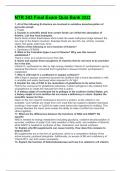
-
NTR 343 Final Exam Quiz Bank 2022
- Exam (elaborations) • 14 pages • 2024
-
- $13.49
- + learn more
NTR 343 Final Exam Quiz Bank 2022 1. All of the following B vitamins are involved in oxidative decarboxylation of pyruvate except: c. Folate 2. Explain in scientific detail how certain foods can inhibit the absorption of thiamin. List four food examples. Some foods contain thiaminases which break the weak methylene bridge between the two rings in the thiamin structure. Example foods are raw fish, tea, shrimp, mussels, clams, fish paste, betel nuts, ferns 3. Which of the following is not a...
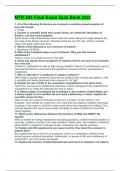
-
NTR 343 Final Exam Quiz Bank 2022
- Exam (elaborations) • 14 pages • 2024
-
- $10.98
- + learn more
NTR 343 Final Exam Quiz Bank 2022 1. All of the following B vitamins are involved in oxidative decarboxylation of pyruvate except: c. Folate 2. Explain in scientific detail how certain foods can inhibit the absorption of thiamin. List four food examples. Some foods contain thiaminases which break the weak methylene bridge between the two rings in the thiamin structure. Example foods are raw fish, tea, shrimp, mussels, clams, fish paste, betel nuts, ferns 3. Which of the following is not a...
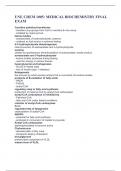
-
UNE CHEM 1005: MEDICAL BIOCHEMISTRY FINAL EXAM
- Exam (elaborations) • 2 pages • 2024
-
- $10.49
- + learn more
UNE CHEM 1005: MEDICAL BIOCHEMISTRY FINAL EXAM Carnitine palmitoyl transferase - transfers acyl groups from CoA to carnitine & vice versa - inhibited by malonyl-CoA ketone bodies - acetoacetate, β-hydroxybutyrate, acetone - oxidized as fuel source in extreme fasting d-3-hydroxybutyrate dehydrogenase interconversion of acetoacetate and 3-hydroxybutyrate acetone yielded by spontaneous decarboxylation of acetoacetate; waste product acetoacetate and 3-hydroxybutyrate - ketone bodies p...
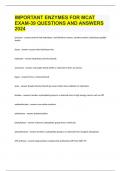
-
IMPORTANT ENZYMES FOR MCAT EXAM-39 QUESTIONS AND ANSWERS 2024.
- Exam (elaborations) • 4 pages • 2023
- Available in package deal
-
- $14.99
- + learn more
protease protein that hydrolyzes, and therefore cleaves, another protein; hydrolyzes peptide bonds. lipase enzyme that hydrolyzes fats. 6 Ways to Show Appreciation for Your Child's Teacher 0:00 / 0:54 hydrolase hydrolyzes chemical bonds. isomerase rearranges bonds within a molecule to form an isomer. ligase forms a chemical bond. lyase breaks chemical bonds by means other than oxidation or hydrolysis. kindase transfers a phosphate group to a ...
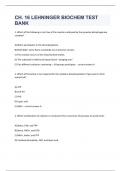
-
Test Bank for Lehninger Principles of Biochemistry 7th Edition by Nelson (complete, questions/answers/rationales)
- Exam (elaborations) • 30 pages • 2023
-
Available in package deal
-
- $14.99
- + learn more
1. Which of the following is not true of the reaction catalyzed by the pyruvate dehydrogenase complex? A) Biotin participates in the decarboxylation. B) Both NAD+ and a flavin nucleotide act as electron carriers. C) The reaction occurs in the mitochondrial matrix. D) The substrate is held by the lipoyl-lysine "swinging arm." E) Two different cofactors containing —SH groups participate. A 2. Which of the below is not required for the oxidative decarboxylation of pyruvate to for...
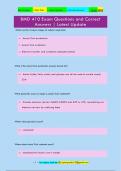
-
BMD 410 Exam Questions and Correct Answers | Latest Update
- Exam (elaborations) • 27 pages • 2024
-
- $12.49
- + learn more
What are the 3 majors stages of cellular respiration Acetyl CoA production Acetyl CoA oxidation Electron transfer and oxidative phosphorylation What is the Acetyl CoA production process shared by? Amino Acids, Fatty acids, and glucose can all be used to create acetyl CoA What generally occurs in stage 2, acetyl-CoA oxidation? Creates electron carriers NADH, FADH2 and GTP or ATP; reoxidizing our electron carriers by reducing them Where does glycolysis occur? c...

Study stress? For sellers on Stuvia, these are actually golden times. KA-CHING! Earn from your study resources too and start uploading now. Discover all about earning on Stuvia


